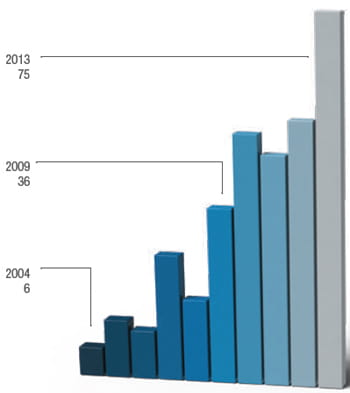Prepared For Emergencies

Review helps Emergency Medicine prepare for a future filled with uncertainty
As director of the Division of Emergency Medicine at Cincinnati Children’s for 22 years, Richard Ruddy, MD, knows how to make things better. Whether working to improve systems within the hospital, leading the Section of Emergency Medicine of the American Academy of Pediatrics or reviewing operations at other emergency departments around the country, Ruddy has developed a keen sense of what it takes to transform emergency services for children.
He also knows that earning a place as one of the nation’s top pediatric emergency medicine divisions requires regular checkups. Which is why he has looked forward to each of the four Scientific Advisory Committee (SAC) reviews he has gone through during his time here.
 |
|
The Division of Emergency Medicine has dramatically increased it’s peer reviewed publications since 2004. |
“I actually like the process,” Ruddy says. “It has led to important changes in the growth and goals of the Division of Emergency Medicine, and it parallels the ability of the division to do its own strategic and tactical planning. It’s a very positive experience.”
AN UNVARNISHED LOOK
Every five years or so, SAC review requires that a division presents a comprehensive overview of what it is doing and learns what it needs to do to be at the top of its game. The process “involves everyone,” Ruddy says, including research, clinical care, education, advocacy and work that crosses division lines.
And the process is not intended only to showcase what is working well.
“It has really become critical to think about the problems to solve, as opposed to the accomplishments that have been made,” says Ruddy. “I like the fact that it addresses all the important questions and gets us closer to being the best we can be.”
Jacqueline M. Grupp-Phelan, MD, MPH, Research Director in the Division of Emergency Medicine, says she appreciates the perspective provided by the review.
“Because of the reputation and experience of our SAC reviewers, we are able to understand where we fall with respect to other top programs nationally. The serial nature of the review process is essential in understanding where we have come from, where we are now and most importantly, where we need to go. We are lucky to have the SAC review to push on our strengths and improve on our weaknesses.”
 |
|
For Dr. Richard Ruddy, SAC review is an opportunity to focus on problems needing to be solved. “I like the fact that it addresses all the important questions and gets us closer to being the best we can be.” |
The division sends the visiting reviewers electronic binders of documentation in advance.
“The information gives reviewers an overview of our current state, where we believe we are headed with our strategic planning and the key questions we want them to address,” says Ruddy.
INVOLVING EVERYONE
Ruddy’s team had definite ideas about what they wanted to focus on in this year’s review.
“We knew our need to be the best pediatric ED would include looking at the physical plant of the ED for the next 20 years, how to develop areas that could put us in the lead nationally, and what it would take to develop people, our most important resource.”
Ruddy works to create an environment in which all staff feels comfortable talking with the reviewers. “It is an opportunity for junior staff and trainees to describe things that should happen in the next several years, in a non-threatening environment.”
Joseph Luria, MD, Associate Director of the Division and Medical Director of the Clinical Services, says this approach provides more honest feedback.
“The reviewers had time to spend with our staff without leadership present,” Luria says, adding that the resulting suggestions offered new ideas ranging from telehealth systems and facility upgrades to shift schedules and work-life balance.
“We are now going through the process of prioritizing projects so we can address the feedback in a meaningful way,” Luria says. “I think this will set the stage for the development of our ED clinical practice over the next three to five years.”
PREPARING IN THE FACE OF UNCERTAINTY
Even the best SAC review generates some anxiety, says Ruddy – primarily concerns about how staff will be involved and what the future will bring. In preparation for this year’s review, Ruddy did something he had not done for previous reviews – he asked peers from around the country what challenges they face.
Research funding, health care system change and the stress on the medical education system came up again and again.
THE CHALLENGE OF RESEARCH FUNDING
Concerns about research funding topped everyone’s list.
“We’ve had great research funding for the last five years, but like other departments, we’re nervous about the funding difficulties the NIH is feeling right now,” Ruddy says. Although the division has $5.6 million in research projects currently underway, Ruddy worries that future funding will be a challenge for young and mid-level investigators.
REFORM AND WHAT IT MEANS
Another issue that came up frequently in Ruddy’s poll of his peers was how healthcare payment reform and the pressing need to provide higher quality, integrated care will affect the face and future pediatric emergency care.
“Everyone is wondering about the Affordable Care Act and the expense of care issue,” he says. “It’s not clear we will have the financial resources in the future, but we will not and should not turn away patients needing care.”
Ruddy says change will not happen quickly, and in the meantime, emergency departments need to plan for the future.
“You can’t tell people not to go to the ER if they don’t have access to what we would call the ‘ideal medical home.’ We are the front porch of the medical home, always open. We need to be creative about how we can do what is best for patients in the new environment of the next five to 10 years in healthcare.”
EDUCATING FUTURE PROVIDERS, EDUCATORS AND LEADERS
The third concern is the stress on training programs for pediatric emergency medicine specialists.
Federal funding for training is at significant risk. And changes in training program requirements could reduce the face time with patients that is so important to becoming the kind of provider patients and families deserve,” Ruddy says.
The SAC reviewers agreed for the most part that the issues identified by Ruddy and his colleagues were the right ones to be thinking about. And although the review cannot resolve all the questions, it goes a long way toward helping the division be as prepared as possible for the coming changes.
“By taking stock of our methods, goals and strategies on a regular basis, the Division of Emergency Medicine will be well prepared to accept the challenges that we anticipate and those we don’t,” Ruddy says. “The most important thing is, we have to be ready for whatever comes our way.”



